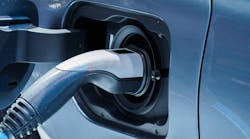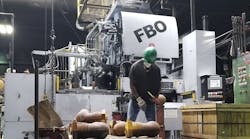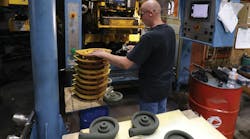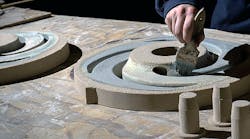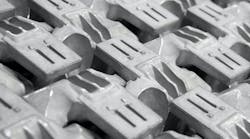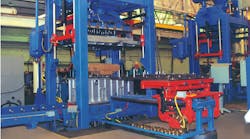At its beginning in 1982, EMI addressed automakers’ need for prototype and production Isocure and shell cores, in particular for Ford Motor Co. and General Motors Corp. With insights gained in those efforts, the patented EMI CB Series of high-production, vertically parted Isocure core machines emerged, again filling a need in the market.
The first market that had the need was the railcar industry which benefited greatly by have a single machine blow and cure a 800# core in a single blow, every 75-90 seconds. The machine was equipped with a quick-change tooling feature along with external core pick-off. This technology replaced the time consuming and expensive task of blowing smaller cores and gluing them all together. In addition to the 800# machine, EMI also offered machines for 100#, 200#, 300#, and 500# cores.
With the purchase of the Sutter core machine technology in 2001, EMI began to incorporate its own insights with that globallyBecause of the success with large core machines, customers asked for even larger, single-blow machines. This request spurred the development and patenting of the 3-in-1 blow-tube technology. Research and development projects are not normally undertaken by a company the size of EMI but the market asked us to adapt so that we could offer a less expensive option to make cores such as 1,000# locomotive bolsters and difficult cores such as brake rotors.
The main benefit with the 3-in-1 blow tube is the ability to blow, tamp, and gas without shuttling the blow head and gassing head. Using this blow-tube technology allows for a machine with a smaller footprint and smaller hydraulic power unit that transfers into cost savings for the customer.
In addition to the new core machine market, EMI was invited early on by customers to fill a need for remanufactured Isocure and shell core machines. Again, drawing on coremaking knowledge and experience, the group began to rebuild equipment from all OEMs, including offered upgrades like PLC panels and proximity switches, and also gave a 180-day warranties (in some cases, a 1-year warranty) on remanufactured machines.
EMI recently began representing Primafond, an Italian core machine manufacturer, in response to customers’ requests for new, inexpensive vertically parted, Isocure machines that are easy to operate and robust in design, with an integrated, reliable, and efficient gas generator.
New Experience, Broader Market
EMI entered the green sand molding machine market in 1986 with the purchase of the Osborn Manufacturing Company’s foundry machine division. Osborn is recognized globally for rugged squeezers, Rota-lifts, and cope-and-drag ram-jolt squeeze molding machines. It’s also known for the Inline series of automatic cope and drag molding lines capable of producing +300 molds per hour. The purchase introduced EMI to a much larger foundry market and its needs.
There was a large market of successful foundries that did not need automated equipment but needed a reliable source for technical assistance and repair parts. This need was, and still is, addressed by manufacturing a standard line of 212/214 RJW jolt squeeze molding machines; 3161/3191 Rota-Lift matchplate molding machines; and the 700 Series of cope-and-drag ram jolt squeeze molding machines.
In addition, after the purchase of Osborn, EMI was asked by a customer to build Osborn Inliner individual molding machines, transfers, separators, etc., and to install these in an existing, high-speed continuous line. We greatly accepted the task and it proved to be the right decision by the customer. They were able to take advantage of new electrical and hydraulic technologies in new equipment but use some of the existing mold handling equipment to realize a substantial cost savings.
This approach has been repeated at other foundries. The Osborn equipment line continues to offer foundries from four to 400 workers the best greensand molding equipment for their needs.
In addition to Osborn, EMI purchased CE-Cast in 1991, which brought high-speed, high-pressure molding via the SPOMatic equipment, along with the aluminum permanent molding benches and turntables, and briquetting presses. Prior to 1991, SPO and CE-Cast produced over 130 high-speed, horizontally parted molding lines, primarily for automakers and Tier One suppliers, but also for the plumbing and fitting market.
Soon after the purchase, a customer asked for an update to certain sections of an aging SPOMatic line. The request was for another custom rebuild to a traditional process line, involving a new separator and a new mold closer, as an alternative to an entirely new mold line.
This request lead to EMI’s Modular Replacements program, which since then has been applied on both Osborn and CE-Cast equipment.
The purchase of the Sutter line of equipment also involved the North American rights to design, build, and service George Fischer Impact Molding machines. Again, customers with existing equipment and those interested in the high technology that GF Impact offers appreciated EMI’s adoption of this line because they know they will have support, service, and design resources available for their equipment.

